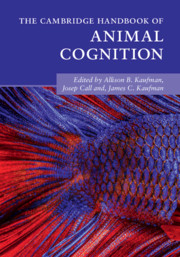Book contents
- The Cambridge Handbook of Animal Cognition
- The Cambridge Handbook of Animal Cognition
- Copyright page
- Dedication
- Contents
- Figures, Tables, and Boxes
- Contributors
- Acknowledgments
- Introduction
- Part I Communication and Language
- Part II Memory and Recall
- Part III Social Cognition
- Part IV Social Learning and Teaching
- 19 Social Learning and Teaching Overview
- 20 Tandem Running Recruitment by Temnothorax Ants as a Model System for Social Learning
- 21 Fish Social Networks
- 22 Social Learning in Birds
- 23 Social Learning in Chimpanzees
- Part V Numerical and Quantitative Abilities
- Part VI Innovation and Problem-Solving
- Index
- References
19 - Social Learning and Teaching Overview
from Part IV - Social Learning and Teaching
Published online by Cambridge University Press: 01 July 2021
- The Cambridge Handbook of Animal Cognition
- The Cambridge Handbook of Animal Cognition
- Copyright page
- Dedication
- Contents
- Figures, Tables, and Boxes
- Contributors
- Acknowledgments
- Introduction
- Part I Communication and Language
- Part II Memory and Recall
- Part III Social Cognition
- Part IV Social Learning and Teaching
- 19 Social Learning and Teaching Overview
- 20 Tandem Running Recruitment by Temnothorax Ants as a Model System for Social Learning
- 21 Fish Social Networks
- 22 Social Learning in Birds
- 23 Social Learning in Chimpanzees
- Part V Numerical and Quantitative Abilities
- Part VI Innovation and Problem-Solving
- Index
- References
Summary
This chapter is an overview of the field of animal social learning (including teaching). It covers how and why social learning is studied in both captive and wild animals, by researchers from various fields with different agendas.I outline the state of play, in studies of captive and wild animals, regarding (i) the various ways in which individuals may learn socially (social learning processes), (ii) the biases they may have in this learning (social learning strategies or transmission biases), and (iii) the evidence for culture and cumulative culture.The interdisciplinary nature of the field is emphasized, through discussion of its influences on theories regarding modularity in the brain (the biological basis of social learning), the evolution of social intelligence, and animal conservation and welfare.
Keywords
- Type
- Chapter
- Information
- The Cambridge Handbook of Animal Cognition , pp. 443 - 471Publisher: Cambridge University PressPrint publication year: 2021



